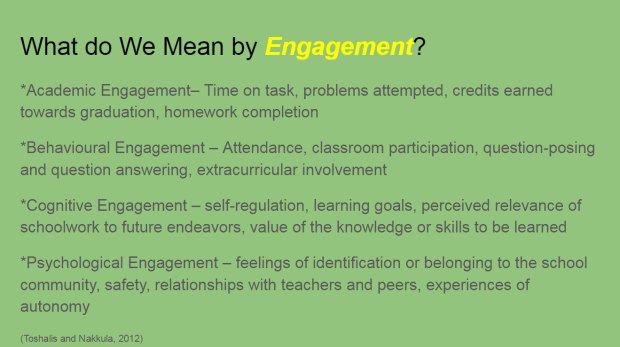Can belonging be measured by student attendance? I believe so, but carefully.
I recall a number of years ago one of our secondary schools was working on improving the engagement of the learners in their school and using attendance data as one measure. Although they didn’t know it at the time, by using attendance data, what they were really measuring was Behavioural Engagement (Toshalis and Nakkula, 2012); which includes attendance, classroom participation, question-posing and question answering, and extracurricular involvement. If I recall correctly, they were also using student achievement data to measure the other forms of engagement, as defined by Toshalis and Nakkula, 2012, in their research paper entitled, “Motivation, Engagement and Student Voice” (2012)…one of my favourites as many of my colleagues know and which has informed our BLPSA: 
What they discovered was that they needed to look at the “attendance story” of each student (which our small size allows us to do), as there were surprises; some of the academically solid students missed a large number of days due to extracurricular involvement – sports days, hockey, music, dance, etc. – and they began to wonder about the impact of this level of involvement – knowing as well that it was important to the well-being and sense of belonging of those students. They discovered that there really were only a few students who they has serious concerns about as they rarely attended school, however they began to intervene for all situations. They did achieve some success that year in this work.
The point is that this school was, as are many of our schools today, “on to something” as we know that “successful schools begin by engaging students and making sure that they come to school regularly” (Ontario Ministry of Education Presentation, February 2016). “If they aren’t in school, they don’t learn. Improving school attendance improves success in school.” (Bruner, Discher, Change, Attendance Works, http://www.attendanceworks.org, cited in Ontario Ministry of Education Presentation, February 2016). We also know that poor school attendance increases the risk of students leaving school early, and that the research shows that the context of the school makes little difference (small school versus large school, rural versus urban). We also know that poor attendance begins in early elementary school, and grows increasingly by grades 6, 7 and 8. Thus, we are all paying closer attention to the overall attendance of our students and are beginning to increase our levels of intervention.

Every School Day Counts, Every School Day is Important
This is because the province of Ontario is beginning to shine a “spotlight” on the need for schools to be knowledgeable about attendance including relevant legislation, the current research, the factors impacting attendance, and best practices to make the necessary change as these are all factors that need to be considered as we engage in the analysis of our data. So what are some things that we need to know?
- “Persistent Absenteeism” can be considered to be “any student/pupil who has missed 10% or more of school days for any reason, including unexcused or excused absences, over an academic year” (Ontario Ministry of Education Presentation, February 2016).
- The Education Act specifies that it is the duty of the principal to ensure that attendance is recorded. 265(1)(c)
- Compulsory Attendance – Students who are between the ages of 6 and 18 are required to attend school daily.
- Attendance is excused if a student is receiving satisfactory instruction at home or elsewhere, due to illness/medical, there is no school/transportation depending upon their age and distances, has obtained a secondary school graduation diploma, receiving music (half day/week), expelled, suspended, excluded, due to a holy day, etc. Section 21(2).
Data to Consider:
- During the 2013-2014 school year, 12.8% of elementary students were “persistently absent” from school. English Language boards were at 13.2% and French Language boards were at 5.1%.
- During the 2013-2014 school year, 1 in 8 elementary students were “persistently absent” from school in Ontario.
- During the 2013-2014 school year, 1 in 5 elementary students were “persistently absent” from school in the Thunder Bay region.
- During the 2013-2014 school year, 1 in 4 elementary students were “persistently absent” from school in the Superior-Greenstone District School Board. We had the second highest rate of absenteeism in the province.
- That year, in Ontario, there was a 19% achievement gap in Grade 6 Math between Grade 6 students who were persistently absent and student who were not.
Responding to this Data:
As the school describe above discovered, it is the conversations that we are having/must begin having about attendance that will be the catalyst for change as we learn that we need to re-culture our expectations about attending in our district school board. Raising the level of awareness about the impact of attendance not only on student achievement but on a student’s sense of belonging ultimately results in intervention and an increasing level of support for some students. We must educate and support parents/caregivers early on and consistently (remember the letters that principals were sending home with report cards providing information regarding the need to improve attendance?) in understanding that they are the “greatest enablers of poor school attendance” (Ontario Ministry of Education Presentation, February 2016), while at the same time ensuring that our policies and procedures keep students in school. This would include a deep analysis of the “attendance culture” in our schools, asking ourselves what the alternatives are for some suspensions, what happens on snow days (do we capitalize on the small number of students and provide for some targeted instruction?), the approach that is taken when students are removed for vacations, the communication with local organizations around the scheduling of tournaments and competitions (which we all acknowledge are critical for our students), how we are role modelling daily attendance, and the list could go on and on. However, critical to this discussion is the notion that we need to figure out if students are absent because they don’t feel as sense of belonging or are if they absent because the culture of our region makes it okay to miss school?
I appreciated the Ministry of Education for providing us with some questions to consider as we engage in these dialogues:

We need to remember that students gain a sense of belonging to the school and engagement in their learning when they are at the center of this learning, when they “own” their learning, are active participants, seeing the relevance and having some control over their own learning and to achieve their own success. Might some students want come to school if our classrooms were increasingly student centered? What if we help our communities to understand that all student MUST be in school every day?
Until next week: How are you engaging in your students’ attendance data to further this conversation with staff, parents, students and community?
As for your other posts thanks for being timely and responsive in your posting. Certainly this is an opportunity for us to reflect on our continued role of attendance counsellor. Perhaps we need to be looking at data retrieval by the attendance counsellor from our elementary schools. What are those pro-active pieces that will support families and students from the time they start school and their transition to high school. The patterns start early- how do we break that cycle? Thanks for sharing and provoking thinking and conversation!
LikeLike
For sure Heidi! I know that we echo your thinking – it is an “all hands on deck” approach for each of us where we each ask how we can make the positive difference!
LikeLike
I was just speaking to a parent who had read this blog and she was commenting to me about SNOW DAYS. She is growing frustrated with navigating the tension that exists on snow days between her child and the idea that she expects her child (they live in town) attend school when the buses do not run, but that her child tells her that “nothing happens on snow day so why do I have to attend?” What really happens on snow days that reflects each school’s culture of learning? Do we all seize the opportunity to deeply support a smaller number of students in closing their learning gaps? That way we aren’t continuing with the planned program as we want to ensure that many students don’t miss out, but we are still engaged in learning. I wonder how this approach would support the growth in student achievement and in belonging? Just a capture of our dialogue – thanks to this parent for allowing me to share her thinking anonymously!
LikeLike
There are 194 instructional days in a school year. Students are considered persistently absent if they are absent for 10 percent of the days they were expected to be in school. This amounts to 19.4 days absent in an academic year. The correlation between persistent absenteeism and academic achievement is strong. In a study conducted in Los Angeles researchers found students who missed on average two days a month in elementary school stood a 60% chance of dropping out in Grade 9, (Every School Day Counts: Persistent Absenteeism in Ontario, 2016)
Among elementary students in Ontario in the 2013-14 school year 12.8 per cent were persistently absent. Among elementary students in the northern regions (Sudbury, North Bay and Thunder Bay), students in Northwestern Ontario had the highest rates of persistent absenteeism at 21.6 per cent. In the same year the persistent absenteeism rate in the Superior-Greenstone District School Board was 26.7% the second highest among school boards province wide. Students in Grade 6, who underwent the EQAO assessment, had the highest rate of absenteeism rate at 41% compared to the provincial average for this grade level of 11.8%. (Every School Day Counts: Persistent Absenteeism in Ontario, 2016)
In 2013-14 the EQAO assessment results for the Junior Division (Grade 6) were as follows;
Reading – 55% Achieved the Provincial Level 3 or 4 compared to the Provincial Average of 79%
Writing – 49% Achieved the Provincial Level 3 or 4 compared to the Provincial Average of 78%
Mathematics – 18% Achieved the Provincial Level 3 or 4 compared to the Provincial Average of 54%
Absenteeism has a direct impact on student achievement. If children are not attending school they are not learning. While addressing persistent absenteeism is a provincial concern there is an immediate need to address the issue in our district. We need to gather further data to determine if this is an on-going trend and determine the extent to which chronic absenteeism is a problem. We also need to ask why students are missing school and identify common barriers to attendance. And through this process we need to involve stakeholders both internal and external.
LikeLiked by 1 person
Thanks for this post, Nicki – this information encourages us all to think about our part in our students’ attendance. I was thinking the same thing as Dave about student voice. Once we dig into our data, I think it is very important to have the conversations with each student who may have higher than normal absenteeism to ask them why and to also find out their perspective on the importance of attending. I am confident their insights will lead us to our next steps in improving our statistics.
LikeLike
I am so happy that you are focusing on attendance as it affects student learning. As you mentioned, our statistics are alarmingly high and we are seeing this in school success and credit accumulation rates. In Geraldton, I can say that the number one inhibitor of course success is attendance, and unfortunately, this seems to be a growing issue. The results of this is frustrating, too: huge bottlenecks especially at the grade 9 and 10 applied level, where timetable limitations sometimes means only one section of a course. This creates a domino effect, resulting in less teacher-student time, difficulties with assessment, evaluation, and reporting, and classroom management issues. Is Geraldton alone in this regard? Are our socioeconomics that different from elsewhere in the board or the province? I would suggest that in some ways, there is truth to those points. There is still a certain amount of mistrust and undervaluing of education among some of our students and their families. Evidence of this can be found in the Truth and Reconciliation Report. We also have students who are traveling large distances, meaning missed buses are perhaps more common than in other areas. Regardless, educators know it’s an issue but feel helpless because it often seems like something out of our hands.
I believe a partial solution – or at least a move in the right direction – is a continued focus on relationship building.
As you mentioned, we have been focusing on relationship building and engagement in our schools. This includes everything from creating a welcoming environment, to fostering inclusiveness, communicating with home, and providing an engaging environment. I think we made a mistake in including relationship building in our SLP last year. This is because an SLP requires hard data to track success or failure, and what we found was that much of the data related to relationship building/engagement was soft/anecdotal. Yes, there are tools like attendance, lates, and surveys that do provide some quantifiable information, but then we get lost focusing on data rather than the big picture, which is getting our students to come to school. While our efforts were good, (and they continue to be implemented), the line between data collection and conditions for learning for the sake of learning needs to be considered.
In the meantime, what else can we do? Might I suggest lobbying for a modernization of the provincial funding formula, so we aren’t bogged down each year fighting for specific GSNs to support our students. We have some awesome things like our Bridging Program and Aboriginal programming, but every year involves so much work to reapply for funding.
Also, I think it’s necessary to continue sharing best practices. Our schools have been doing a great job sharing on social media, and I think seeing what motivates our students in other places is awesome. Kudos to those who take the time to take pictures, write, and share. It is appreciated.
Finally, we need to continue modelling engagement. It’s easy to feel discouraged when absences and lates stack up but we have to continue holding our students accountable while maintaining a positive, welcoming presence in our schools.
Once again, I’m glad to see that this issue is being openly discussed.
LikeLike
Thanks for your post and for sharing your thinking Steve. Your blog was insightful and encouraging…with your positive, learner mindset approach to a complex topic! I appreciate that approach very much.
I think that focusing on relationship building is an important part of the work as you point out, however there are a couple of points that are critical to ensure impact. When we focus on building relationships, what does success look like and sound like? Have we delved deep into the research about what factors/best practices need to be in place to ensure that our relationship work can actually be attributed to a change in learning? What precisely did we do differently than we have not done before to improve relationships with students that we were seeing making a difference in the learning in the classroom? This leads to the measurement piece. When we focus on relationships, we should see students able to increasingly take risks, collaborate in learning, feel a sense of belonging in the learning environment, etc. This plays out in terms of student achievement – which we need to measure using collaboratively determined Overall Expectations or an aspect of the Achievement Chart or Learning Skills (using a diagnostic followed specific and “new” instruction related to the “relationship building focus”, followed by a summative). When we measure our impact using data such as lates and attendance, there are so many factors that impact attendance (that you have pointed out nicely in your post), I am not sure we can make the direct measurement or correlation to our goal. This work isn’t perfect, nor is the data that we are collecting completely variable free (kinda like report card evaluations!), however it is our response to the data that is the key. We will likely never reach a point where we can be certain of our quantitative data; it is what we learn from that journey and how we respond to impact students that will make the difference. Attendance data is one area where we have quantitative data, however it is the many stories behind that data that we need to respond to in a non-judgmental way, positive way…as you indicated, relationships are key to that response!!!
Your point about the “big picture” is certainly true and made me think about our BLPSA Theory of Action – how the one page summary represents all of the areas of focus that are necessary to shift to an increasingly student centered environment and student centered pedagogy. There is so much overlap among all of those areas of focus – spotlighting one area definitely leads into another, and another…as my example from above about how relationship building results in risk taking and collaboration, and thus allows for students to increasingly engage in the co-construction of success criteria, which, when used and applied deeply, leads to a greater ability to set goals and for students to see their own learning progress, which leads to an improved Learner Mindset (efficacy and growth mindset)…and on and on it goes!! There is a need to spotlight in order to manage this big picture, knowing which area will have the greatest impact on the most urgent learning needs of our students, as identified through our curriculum documents.
LikeLike